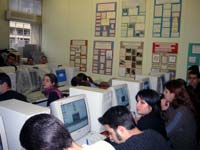1. Molecular Biology & Genomics
Coordinator: Assoc. Prof. G. Rodakis
Lecturers: Assoc. Prof. G. Rodakis | Assis. Prof. A. Katsiotis | Lecturer G. Goulielmos | Assis. Prof. G. Diallinas
Compulsory Module
Semester: Α
Syllabus:
- Molecular components of organisms, Genome, genes, DNA, RNA, proteins, Flow of Genetic information. DNA synthesis, cell division and cell cycle regulation. Structure and function of genes.
- Transcription and regulation of the transcription process in A) prokaryotic genomes, positive and negative regulation, repressors, operators, promoters, operons B) eukaryotic genomes, chromatin structure, chromosomes, organization of genomes at the sequence level (repetitive DNA, exons, introns, retrotransposons, gene families).
- Eukaryotic RNA polymerases, transcription factors - A transcription factor case study. Translation and post-translational modification's regulation. Genetics of bacteria and phages.
- Basic principles of Genetic Engineering. Isolation of gene-target, construction of a 'synthetic' gene cloning, PCR, clone selection. Gene libraries. Applications of genetic Engineering in Medicine (medical products, genetic identity, gene fingerprints, molecular basis of this process).
- Technology of transgenic animals. Transgenic mice as biomedical models.
- Searching genes through the Internet. Genetic and physical mapping. Alternative methods and examples (linkage analysis and reverse genetics)
- Drosophila melanogaster's genomic map. Genome mapping of Arabidopsis thaliana, Caenorhabditis elegans, Anopheles stephensi.
- Human Genome Project. Common diseases' gene mapping. Moral dilemmas. Gene Therapy - Somatic cells, stem cells
- Gene therapy for various cancer forms, gene therapy of inherited neurological disorders.
2. Biomolecular Structure and Function
Coordinator: Prof. S. Hamodrakas
Lecturers: Prof. S. Hamodrakas | Prof. E. Iliopoulos | Prof. E. Moudrianakis | Assoc. Prof. K. Vorgias | Dr. M. Vlasi | Dr. V. Oikonomidou
Compulsory Module
Semester: Α
Syllabus:
- Molecular structures at atomic level and implications in Biology. Historic overview
- Biological macromolecules, Three-dimensional conformation, Weak interactions and their importance in the phenomenon of life, Biological macromolecules in hydrophilic and hydrophobic environment, Symmetry, Macromolecules and Structures.
- Protein structure determination methods
- Protein architecture, Sequence, Secondary structure, Surer-secondary structures, Structural Domains, Tertiary structure, Protein-protein interactions.
- Membrane proteins, Hydrophobicity and protein-lipid interactions, Energy & Signal transduction- Molecular machines, Selected model systems at the atomic level (recently determined high-resolution structures and their probable functions e.g. bacteriorhodopsin, rhodopsin)
- Structural proteins, Collagen, Super-helices, Silk, Amyloids, Amyloidosis, Biopolymers/Biomaterials.
- DNA-binding proteins, Protein-DNA recognition in euraryotic and prokaryotic organisms, protein-DNA interactions, Supercoiled DNA, Nucleosome structure
- Polysaccharides (Chitin, Cellulose) & two-phase protein-polysaccharide complex systems
- Protein mechanics, prediction and protein design
- Protein folding & protein stability
- Structural genomics
3. Programming Languages and Software Tools in Bioinformatics I
Coordinator: Prof. S. Hamodrakas
Lecturers: Prof. S. Hamodrakas
Compulsory Module
Semester: Α
Syllabus:
- Introduction
- Data Types:Fundamental data types, definition of octal and hexadecimal constants, types of variables, arrays and strings, enumeration constants.
- Operators:Substitution operator, numeric operators, increment and decrement operators, comparison operators, Boolean logical operators, digital logical operators, hypothetical operator, explicit data type conversion- the cast operator, the sizeof operator, Priorities of operators, mixture of different data types in expressions.
- Control Structures:if structure, while structure, for structure, switch/case structure, continue structure, goto structure, recursion
- Pointers:Definition, pointer variables, applications, Dynamic memory allocation functions.
- Derived data types:Data structures, Bit fields, Unions, Definition of new data type: typedef
- The C pre-processor:Definition of constants: The #define directive, File inclusion: the #include directive, Conditional compilation
- Input/Output and Library Functions:Input/Output functions, other library functions
- The structure of C programs: Functions, Arguments of the main function
- Applications (Simple Bioinformatics Programs)
4. Statistics in Bioinformatics
Coordinator: Assoc. Prof. H. Damianou
Lecturers: Assoc. Prof. H. Damianou
Compulsory Module
Semester: Α
Syllabus:
PROBABILITY
- Sample space and events. Probabilities of events. Basic counting rules. Permutations, combinations. Conditional Probability. Theorem of total probability and Bayes' theorem. Stochastic independence. Random variable. Probability density function and Cumulative density function. Discrete random variables. Continuous random variables. Distribution of random variables. Mean and variance. Bernoulli distribution. Binomial distribution. Geometric distribution. Pascal distribution. Hypergeometric distribution. Poisson distribution. Uniform distribution. Exponential distribution. Erlang distribution. Normal distribution. Gumbel distribution. Approximation of the Binomial and Poisson distributions by the Normal distribution. Distribution of the sum of independent random variables. Central Limit Theorem and applications.
STATISTICS
- Frequency distributions of qualitative and quantitative characteristics. Measures of central tendency and variability. Coefficient of variation. Hypothesis testing. Comparison of mean value with a constant. Comparison between two mean values. Parametric and non-parametric approaches ( t-test, Wilcoxon rank test κτλ). Type I and II error rates. 2x2 tables. Proportions. The χ2 criterion and applications. Parametric and non-parametric correlation coefficient. Simple linear regression. Multiple linear regression. Analysis of Variance, multiple comparisons. Logistic regression. Introduction to multivariate analysis. Statistical packages (SPSS, STATA etc). Practical data analysis using PC .
5. Principles and Methods in Bioinformatics
Coordinator: Prof. S. Hamodrakas
Lecturers: Prof. S. Hamodrakas | Prof. E. Iliopoulos
Compulsory Module
Semester: Α
Syllabus:
- What is Bioinformatics, Definitions
- Computer Science basics - Computer applications in Biology (Biocomputing)
- DNA and protein databases - Specialized DNA and protein databases - Annotation problems
- Protein and Genome Information Resources and analysis tools
- Genomes (Genome Projects)
- The genetic code: One step further - Protein folding - Protein-protein interactions - Metabolic pathways - Protein assembly and self-assembly
- Exploitation of huge amount of data derived from genome analysis, Difficulties in experimental structure determination and function assignment of proteins - Structural Genomics
- Computational analysis to fill in the "gap"
- Data Base Management Systems
- Data Mining
- Introduction in Machine Learning Methods in Bioinfomatics
6. Application of Informatics in the Study and Preservation of Biodeversity
Coordinator: Assis. Prof. A. Legakis
Lecturers: Assoc. Prof. A. Nikolaidou | Assis. Prof. A. Legakis | Lecturer P. Megalofonou
Compulsory Module
Semester: Α
Syllabus:
- Biodiversity data: Forms, Categories, Usage
- Methods for the analysis of biodiversity: Data Bases, Statistical analyses, Temporal analyses, Spatial analyses, Models, GIS
- Applications of Informatics in Biodiversity: Systematics, Biogeography and evolution (binomial species naming and classification, species description, taxonomy keys and phylogenetic data, sampling and observation data and species distribution), spatial distribution of organisms (Software applications for the analysis of territoriality, correlations of population and ecological factors, statistical analysis of biocommunities), Behavioural analysis, management of biological collections, metadata management, visualisation, knowledge networking, data mining. The application of biodiversity data from non-experts: uncertainty analysis, reasoning with incomplete information, automatic summarization.
|










